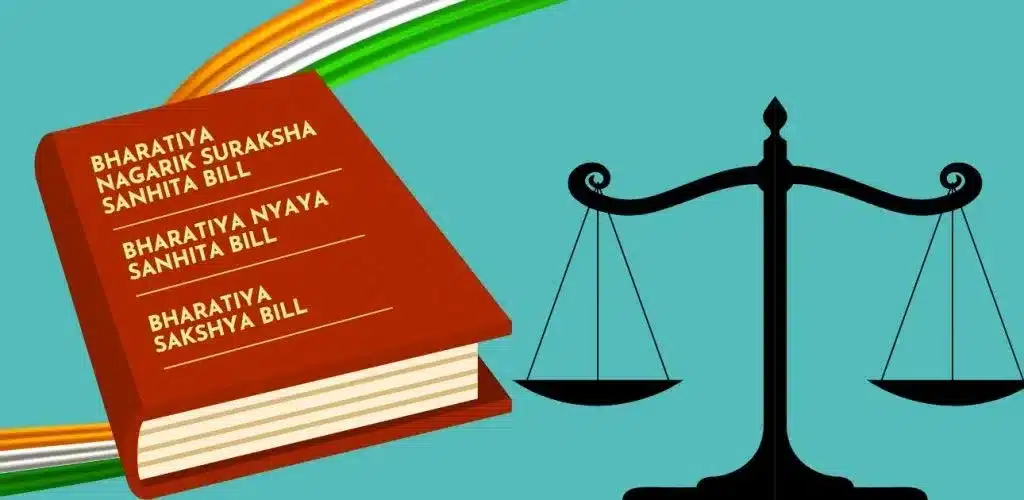What’s in today’s article?
- Why in News?
- Breaking Down the Three New Criminal Laws
- Upsides and Downsides of the Three New Criminal Laws
- Analysing the Government’s Preparation for Implementing the 3 Criminal Laws
Why in News?
- Three new criminal laws – Bharatiya Nyaya Sanhita (BNS), Bharatiya Nagarik Suraksha Sanhita (BNSS), and the Bharatiya Sakshya Adhiniyam (BSA) – came into effect across the country on July 1.
- They brought widespread changes in India’s criminal justice system and ended colonial-era laws – the Indian Penal Code (1860), Code of Criminal Procedure (1973) and the Indian Evidence Act (1872).
- Together, these three laws govern the criminal justice jurisprudence – from defining penal offences, prescribing processes for investigation and evidence gathering to governing the process of a trial in court.
Breaking Down the Three New Criminal Laws:
- The BNS introduces some new crimes: For example,
- Clause 69:
- It penalises sexual intercourse through the employment of “deceitful means” and mentions upto 10 years imprisonment and a fine for the offence.
- Deceitful means include the false promise of employment or promotion, inducement, or marrying after suppressing identity.
- Critics say that this might end up criminalising consensual relationships and provide a fillip to the “love jihad” narrative in some cases.
- Clause 103:
- It (for the first time) recognises murder on the ground of race, caste, or community as a separate offence.
- In 2018, the SC had directed the Centre to consider a separate law for lynching and the new provision gives legal recognition to such crimes.
- Inclusion of offences such as organised crime and terror:
- Clause 111(1) of the BNS borrows heavily from the Unlawful Activities Prevention Act (UAPA).
- Organised crime encompasses any continuing unlawful activity including kidnapping, robbery, vehicle theft, extortion, land grabbing, contract killing, economic offences, cyber-crimes, etc.
- Clause 304(1): It defines snatching as a new crime, distinct from theft.
- Community service as an alternate form of punishment for some offences:
- These include small theft, defamation, and attempt to die by suicide with an intention to keep a public official from discharging her duty.
- However, the BNS does not define what constitutes community service, leaving it to the discretion of judges.
- Clause 69:
- BNSS:
- The expansion of detention in police custody: From the 15-day limit in the CrPC to up to 90 days.
- Victim-centric approach: The BNSS states that in cases where the punishment is seven years or more, the victim shall be given an opportunity of being heard before withdrawal of the case by the government.
- Trials in absentia: Where a person accused of a crime can be tried and convicted in his absence. Critics argue that the introduction of trials in absentia under normal criminal law allows the state to forgo its duty to properly locate the accused before the trial begins.
- Removes the provision for statutory bail: If an accused has more than one offence against his name.
- BSA:
- Modified the definition of document:
- By including electronic and digital records and recognising digital and electronic records as primary evidence.
- Now, the digital or electronic records will have the same legal effect, validity, and enforceability as other documents.
- Expanded the scope of secondary evidence: It included additional categories such as oral admissions, written submissions, etc.
- Modified the need for confessional admission: A confession made by an accused person is irrelevant in a criminal proceeding.
- Modified the definition of document:
Upsides and Downsides of the Three New Criminal Laws:
- Upsides:
- Sexual intercourse with a minor wife has been brought under the ambit of rape.
- The inclusion of offences for mob-lynching is crucial, and signals a legislative acknowledgement of such hate crimes.
- In a progressive step, the BNS entirely leaves out the contentious Section 377 of the IPC which criminalises “carnal intercourse against the order of nature”.
- The emphasis on video-conferencing of trials, and prescription of timelines for speedy trials should improve justice delivery but their success will depend on implementation on the ground.
- Grey areas:
- The consultation process (during pandemic) and the hasty passage of the laws through Parliament has caused much disquiet.
- According to some legal experts, although the new laws make significant changes, they do not ‘overhaul’ the existing laws.
- Despite the government’s claims (of doing away with sedition), the BNS has in fact introduced the offence with a wider definition.
- With rape laws still not made gender-neutral, there is little criminal recourse for male victims of sexual assault.
Analysing the Government’s Preparation for Implementing the 3 Criminal Laws:
- Operational training: For example, the Bar Council of India has mandated that the new laws be incorporated into curricula of universities and Centres of Legal Education from the 2024-25 academic year.
- Publicity/awareness campaign: The Bureau of Police Research and Development (BPR&D) is coordinating efforts of the Inter-Ministerial Group for a coordinated publicity campaign.
- Tech upgradation:
- NCRB has made 23 functional modifications in theCrime and Criminal Tracking Network and Systems (CCTNS) application to facilitate tech compatibility, including on registration of FIRs.
- NIC has developed applications such as eSakshya, NyayShruti, and eSummon to facilitate videography/photography of crime scenes, judicial hearings, and delivery of court summons electronically.
Capacity building: The BPR&D has developed 13 training modules to build capacity of the police, prisons, prosecutors, judicial officers, forensic experts, and central police organisations.
Q.1. What is the Crime and Criminal Tracking Network and Systems (CCTNS)?
CCTNS is a project under the Indian government for creating a comprehensive and integrated system for effective policing through e-Governance.
Q.2. What is the Bureau of Police Research and Development (BPR&D)?
BPR&D was set up in 1970 to further the objectives of the Government of India regarding the modernisation of police forces. It has since evolved into a multifaceted consultancy organisation.
Source: Curtains on old IPC, CrPC, Evidence law, new criminal codes come into effect from today | IE | IE
Last updated on June, 2025
→ UPSC Notification 2025 was released on 22nd January 2025.
→ UPSC Prelims Result 2025 is out now for the CSE held on 25 May 2025.
→ UPSC Prelims Question Paper 2025 and Unofficial Prelims Answer Key 2025 are available now.
→ UPSC Calendar 2026 is released on 15th May, 2025.
→ The UPSC Vacancy 2025 were released 1129, out of which 979 were for UPSC CSE and remaining 150 are for UPSC IFoS.
→ UPSC Mains 2025 will be conducted on 22nd August 2025.
→ UPSC Prelims 2026 will be conducted on 24th May, 2026 & UPSC Mains 2026 will be conducted on 21st August 2026.
→ The UPSC Selection Process is of 3 stages-Prelims, Mains and Interview.
→ UPSC Result 2024 is released with latest UPSC Marksheet 2024. Check Now!
→ UPSC Toppers List 2024 is released now. Shakti Dubey is UPSC AIR 1 2024 Topper.
→ Also check Best IAS Coaching in Delhi






















